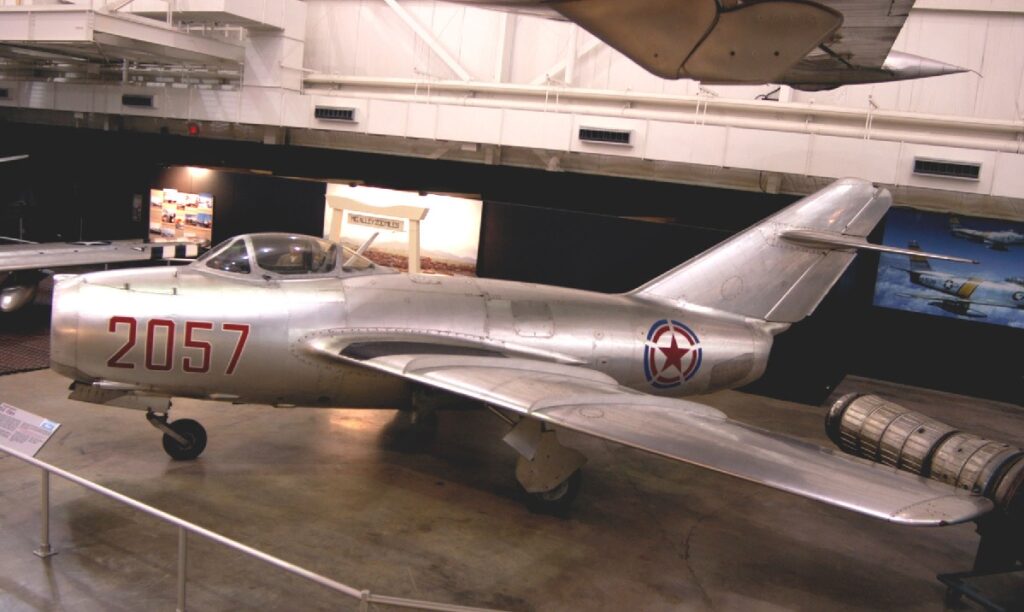When the range was reduced to 200 meters, Snr Lt Khominich started firing three seconds of cannon fire at one of the F-80s (220 yrd). In the first-ever dogfight between jet fighters, the Soviet pilots were said to have shot down the Shooting Star
On June 25, 1950, just before dawn, North Korean forces occupied South Korea. Seoul, the capital of South Korea, was taken three days later, and the UN sanctioned the dispatch of military support, led by the US, to fend off the North Korean invaders.
On July 5, the first American Army units—from the 8th Army—were sent into combat. UN forces were trapped in the Pusan Perimeter on August 4 when North Korean troops reached the Nakdong River in the southeast corner of the Korean Peninsula. In anticipation of a counteroffensive, Gen. Douglas MacArthur, Supreme Commander of UN Forces in Korea, concentrated his soldiers inside the Pusan Perimeter for more than a month.
Ultimately, on September 15, he ordered an amphibious landing at Inchon to take the North Korean troops on the flank. He gave the 8th Army the command to move north from Pusan one week later. By October, North Korean forces had been pushed back under the 38th parallel of latitude, which served as the pre-war border. On October 26, UN troops arrived at the Yalu River near the border with China and Korea.
According to Leonid Krylov and Yuriy Tepsurkaev in their book Soviet MiG-15 Aces of the Korean War, China’s active involvement in the conflict was unavoidable after its leadership issued a warning that it would support North Korea if the 38th parallel was crossed by non-South Korean units. Soviet Air Force units in-theater were entrusted with providing air protection for the Chinese troops, their supply lines, and crucial locations in the country’s northeast during preparations for the ensuing offensive.
The 151st GvIAD (Guards Fighter Air Division) of the Soviet Air Force, which was headquartered in Manchuria, was the primary unit in charge of providing aircraft for these operations. Three of its regiments, the 28th, 72nd, and 139th GvIAPs (Guards Fighter Air Regiments), were stationed at the airfields at Anshan and Liaoyang, close to Mukden, starting in August 1950. Here, they taught Chinese pilots how to fly jets so they could later protect the northeast. The 67th IAP was established by the 151st GvIAD and the 139th GvIAP in late October to form the new 28th IAD.
The 72nd GvIAP’s 1st Squadron was given the order to take to the air at 1350 on November 1. Maj. N. V. Stroykov, a Hero of the Soviet Union (HSU) who flew 245 combat missions during World War 2, participated in 66 air fights and achieved 16 individual and 21 group victories, commanded this unit. On that particular day, Snr Lts Guts and Kaznacheev and Lts Monakhov, Chizh, and Sanin flew the MiG-15s in his formation. In the end, only five MiG-15s were able to take off since Sanin’s was unserviceable.
The others were instructed to proceed to Antung, which is located close to the North Korean border on the Yalu River. The group was given the order to cross the border, begin looking for enemy aircraft, and engage any found. The five MiGs flew far into Korean territory in the southeast.

Guts, who was leading the second pair, discovered three USAF F-51D Mustangs at 14:15. All five MiGs launched simultaneous attacks, but the US pilots were able to avoid a dogfight at first thanks to some skillful flying. Two F-51s made sharp turns, and one half-rolled dived before accelerating and heading south. When the third F-51 dove sharply and broke off to the south, according to Soviet archives, Chizh shot down a Mustang during the second attack (USAF records indicate that no Mustangs were lost).
From 72nd GvIAP’s 2nd Squadron, four MiGs departed towards Antung. The squadron leader, Maj. Bordun, was in command of these aircraft as they passed overhead the Yalu River 26 minutes after Stroykov’s group had done so. The MiG pilots were instructed to return to base by their ground controller around 25 minutes later, and they departed for Anshan. But less than three minutes later, they got instructions to return to Antung to repel an enemy air strike that ground forces had just reported.
While Lt Esyunin returned to base because his plane did not have external fuel tanks and was now out of fuel, Maj Bordun, Snr Lt Khominich, and Lc Sukhov changed course for the Korean border. At 1550 hours, Snr Lt Khominich noticed 10 F-80C Shooting Stars ahead of him. He then launched an out-of-the-sun attack on the leading group of four. He opened fire and peppered one of the F-80s with a three-second burst of cannon fire, ceasing when the range was down to 200 m (220 yrd). In the first-ever dogfight between jet fighters, the Soviet pilots were said to have shot down the Shooting Star.
After a morning airstrike on Sinuiju airfield, one of the USAF’s two F-80s was shot down by anti-aircraft artillery, the USAF acknowledged losing two F-80s on November 1. Although the USAF records contain no mention of the duel between the F-80s and the MiGs, the second jet, from the 49th Fighter-Bomber Group (FBG), was reported as having been shot down on the afternoon of the first during a rocket attack near Unsan. Even though the Shooting Star pilot perished in the battle, it is unlikely that his squadronmates were unaware of the Soviet planes’ attack.
It is unknown from the archives on both sides if Khominich actually won this all-jet clash, and it is also unclear what specifically destroyed the F-80. Clearly, a second Shooting Star was lost on Nov. 1, but where did it crash? Did it fall into the sea or explode in the air? Such queries are yet unaddressed.
Soviet MiG-15 Aces of the Korean War is published by Osprey Publishing and is available to order here.
Photo by U.S. Air Force


